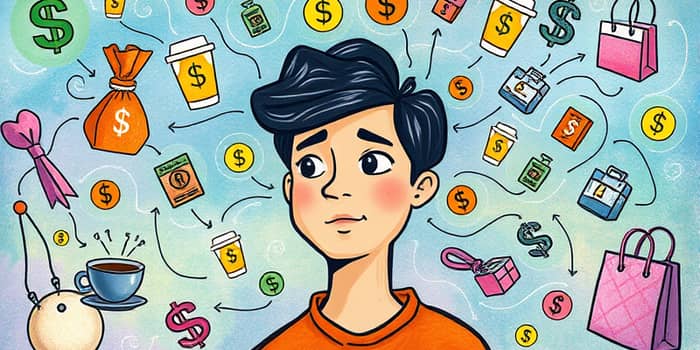Most of us glance at our bank statements and feel confident we know where our money goes. Yet beneath the surface lie countless small leaks that, over time, can erode our financial stability and create stress. By shining a light on the unseen triggers and overlooked expenses, we can transform habits, reclaim control, and set ourselves up for long-term success.
In this article, we explore the latest 2025 data, delve into consumer psychology, present revealing case studies, and offer concrete steps to identify hidden spending patterns. Whether you’re a Gen Z saver, a millennial experience-seeker, or anyone in between, these insights will empower you to uncover opportunities and make every dollar work harder.
Understanding the Big Picture
In 2025, US consumer spending is expected to grow by 3.7%, down from 5.7% the previous year. This deceleration reflects a cooling labor market and policy uncertainty that temper enthusiasm. While high-income households drive aggregate growth—spending an average of $1,400 per month on credit cards—lower-income groups remain vulnerable, averaging just $300 per month. Credit delinquencies are ticking up, although defaults remain low due to historically low unemployment.
Generational habits vary widely. Gen Z trimmed spending by 13% in early 2025, planning to slash holiday expenses by 23%, yet their combined purchasing power could reach $12 trillion by 2030. Millennials continue to prioritize experiences over possessions (nearly 60%), while Gen X blends digital convenience with in-person value hunting. Boomers, often more budget-conscious, still feel the pinch of rising healthcare and housing costs.
The Psychology of Hidden Habits
Our brains are wired to minimize effort and maximize reward. Digital wallets, one-click checkouts, and saved payment info create frictionless pathways for impulsive purchases. Social media amplifies peer pressure—shopping to “keep up” with friends or influencers. Financial secrecy adds another layer: 28% admit hiding purchases from partners, and 21% feel embarrassed about their spending.
Common bad spending habits often masquerade as harmless treats. Recognizing these patterns is the first step toward meaningful change.
- Impulse buying fueled by emotional triggers—96% report at least one impulse purchase, often on groceries or apparel.
- Lack of budgeting or spending tracking—18% regret not monitoring small expenses that quietly add up.
- Reckless overspending on nonessentials—74% admit overspending on groceries, online shopping, and dining out.
- Silent budget leaks from subscription services—the average American pays $219 monthly, yet only half of subscriptions are used regularly.
Where Your Money Disappears
Hidden expenses often hide in plain sight. Daily coffees, streaming platforms, convenience fees and overlooked bank charges quietly chip away at your monthly balance. By annualizing these costs, the impact is startling.
Once you see the figures side by side, it’s clear why these small amounts can lead to missed bills, rising credit card balances, and mounting stress.
Real-Life Impact on Your Wallet
Nearly half of consumers (46%) have missed a bill payment because of nonessential spending, and 15% spend more than they earn. Young adults are particularly prone to impulse buys and financial secrecy, while men are twice as likely as women to skip bills due to discretionary purchases. These behaviors erode credit health, increase stress, and limit future opportunities.
Consider a couple who keep separate finances. One partner racks up $50 per month in streaming services, food delivery, and impulse buys. Over a year, that adds up to $600—enough to cover a family utility bill or pad an emergency fund. Lack of communication can sow mistrust and financial anxiety, undermining both relationships and long-term goals.
Practical Strategies to Reclaim Control
Effective change combines awareness, tools, and accountability. By introducing a little friction, you can curb impulsive decisions and redirect funds toward meaningful priorities.
- Remove stored payment information to force a second thought before each purchase.
- Regularly audit and cancel unused subscriptions to eliminate automatic drains on your budget.
- Track every expense, however small using apps or a simple spreadsheet for full visibility.
- Automate savings and bill payments to avoid late fees and reduce decision fatigue.
- Set clear credit card rules such as paying in full each month to avoid high interest debt.
- Openly discuss finances with partners to build trust and share budgeting responsibilities.
Small changes compound quickly. For instance, skipping a $5 coffee daily and redirecting that amount into a savings account yields over $1,300 per year, plus interest. Removing one unused $15 subscription saves $180 annually. These incremental wins build momentum and reinforce positive habits.
Looking Ahead: Opportunities and Mindset Shifts
Economic headwinds in 2025 suggest continued caution, especially among middle and lower-income groups. However, this environment fosters new opportunities for disciplined savers and value-focused shoppers. Expect to see:
- Heightened digital tool adoption for budgeting, expense tracking, and automated savings.
- Value-driven shopping behaviors, with consumers proactively comparing prices and using promo codes.
- Generational leadership in authentic spending, as younger cohorts champion purpose over status-driven consumption.
By cultivating a mindset that prioritizes conscious spending, you’ll be well-positioned to thrive regardless of broader market fluctuations. The key is to transform awareness into action, and action into lasting habits.
Decoding your spending isn’t just about crunching numbers—it’s about understanding the underlying motivations that drive your choices and leveraging insights to create positive change. Start small, stay consistent, and celebrate each milestone along the way. Over time, what once felt like a series of hidden leaks will become a clear, intentional path toward financial resilience and freedom.
References
- https://www.morganstanley.com/insights/articles/us-consumer-spending-trends-2025
- https://mooremomentum.com/blog/10-bad-spending-habits-that-keep-people-broke/
- https://www.pwc.com/us/en/industries/consumer-markets/library/gen-z-consumer-trends.html
- https://listwithclever.com/research/bad-spending-habits-2024/
- https://www.bostonfed.org/publications/current-policy-perspectives/2025/why-has-consumer-spending-remained-resilient.aspx
- https://www.associatedbank.com/education/articles/personal-finance/budgeting/bad-spending-habits
- https://www.mckinsey.com/industries/consumer-packaged-goods/our-insights/how-todays-consumers-are-spending-their-time-and-money
- https://www.td.com/ca/en/personal-banking/ready-advice/6-spending-habits-that-can-sneakily-add-up
- https://newsroom.bankofamerica.com/content/newsroom/press-releases/2025/07/confronted-with-higher-living-costs--72--of-young-adults-take-ac.html
- https://www.alphawealthfunds.com/2025/02/hidden-costs-that-drain-your-budget-and-how-to-avoid-them/
- https://www.deloitte.com/us/en/insights/topics/economy/consumer-pulse/state-of-the-us-consumer.html
- https://nielseniq.com/global/en/insights/report/2025/the-x-factor/
- https://khoros.com/blog/millennial-buying-habits










